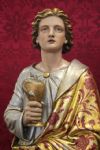THE HISTORY OF ST JOHN'S
A Rural Parish
 Until the early 19th century the land upon which St John's Church
was built was a field owned by All Souls' College, Oxford. The shape of the
field can still be seen as it borders the Harrow Road and Kilburn Lane. All
Souls' was also to donate the land which became the west London cemetery, whose
official name is "All Souls' Cemetery". In the 1880's All Souls
developed its land north west of Kilburn Lane, hence All Souls Avenue and
College Road. Many of the other roads were named after leading College fellows.
Until the early 19th century the land upon which St John's Church
was built was a field owned by All Souls' College, Oxford. The shape of the
field can still be seen as it borders the Harrow Road and Kilburn Lane. All
Souls' was also to donate the land which became the west London cemetery, whose
official name is "All Souls' Cemetery". In the 1880's All Souls
developed its land north west of Kilburn Lane, hence All Souls Avenue and
College Road. Many of the other roads were named after leading College fellows.
 St John's was built as a response to the growth of London,
although in 1851 only around 800 people lived around Kensal Green. The church
opened in 1844 and contemporary prints show it in a rural setting. This archive image (courtesy of Lambeth Palace Library) shows the original ground plan of the church. The signature of the first vicar, Arthur Gore Pemberton, can be seen in the bottom left corner. The document is also signed by the celebrated 19th century author, William Harrison Ainsworth who was one of the first churchwardens.
St John's was built as a response to the growth of London,
although in 1851 only around 800 people lived around Kensal Green. The church
opened in 1844 and contemporary prints show it in a rural setting. This archive image (courtesy of Lambeth Palace Library) shows the original ground plan of the church. The signature of the first vicar, Arthur Gore Pemberton, can be seen in the bottom left corner. The document is also signed by the celebrated 19th century author, William Harrison Ainsworth who was one of the first churchwardens.
 The church interior also
looked very different. At the east end was a flat wall with a rose
window which was replaced in the early twentieth century by a new
chancel (including the present stone High Altar) and was consecrated in
March 1903. Pews once filled the church and both the organ and font were in
different positions.
The church interior also
looked very different. At the east end was a flat wall with a rose
window which was replaced in the early twentieth century by a new
chancel (including the present stone High Altar) and was consecrated in
March 1903. Pews once filled the church and both the organ and font were in
different positions.
In the early 19th century new vestry rooms were added to the original vestry; the latter becoming a boiler house. In 2016 the old vestry was restored to its original use following the relocation and replacement of the boiler. The archway which surrounds the statue of Our Lady of Walsingham was originally the site of the door into the vestry, long since blocked up.
War Damage
 Until the second world war the
original ceiling, arch and chancel ceiling decoration could still be be seen. However following war damage (which destroyed much of the original glass) the church required
structural support and steel beams were erected to support the roof. A ceiling
was then placed beneath the beams which remains in place today but, it is still possible to
see the original roof via the bell tower. Sharp eyed visitors will
notice that the window beneath the clock face can be seen from outside the
church, but not from within! The chancel ceiling decoration, painted at the
very end of Queen Victoria's reign, is in remarkable condition but hidden
from view by a panel.
Until the second world war the
original ceiling, arch and chancel ceiling decoration could still be be seen. However following war damage (which destroyed much of the original glass) the church required
structural support and steel beams were erected to support the roof. A ceiling
was then placed beneath the beams which remains in place today but, it is still possible to
see the original roof via the bell tower. Sharp eyed visitors will
notice that the window beneath the clock face can be seen from outside the
church, but not from within! The chancel ceiling decoration, painted at the
very end of Queen Victoria's reign, is in remarkable condition but hidden
from view by a panel.
In 1944, St John’s centenary year, the rood (the wooden crucifix and statues of St Mary and St John) was erected as an act of thanksgiving for 100 years of church life.
The church clock was added to the church in
1916 and in October 2016 we celebrated its centenary. There is one church bell, although the
south tower was intended to hold more; something that might well be
realised over time.

170 Years of Service
St John's Church was Consecrated on August 8th 1844 by the Bishop of London and on 6th July 2014 we celebrated St John's
170th Anniversary. A service of thanksgiving was held for the recent restoration
work and renewal of the church clock. The service, led by the Bishop of Fulham,
was attended by many friends of St John's and past parishioners. The occasion
also provided an opportunity for focusing on the future, particularly our
development plans so that we can offer our church for wider community use.


Contact
St John's Vicarage
Kilburn Lane
London
W10 4AA
020 8969 2615